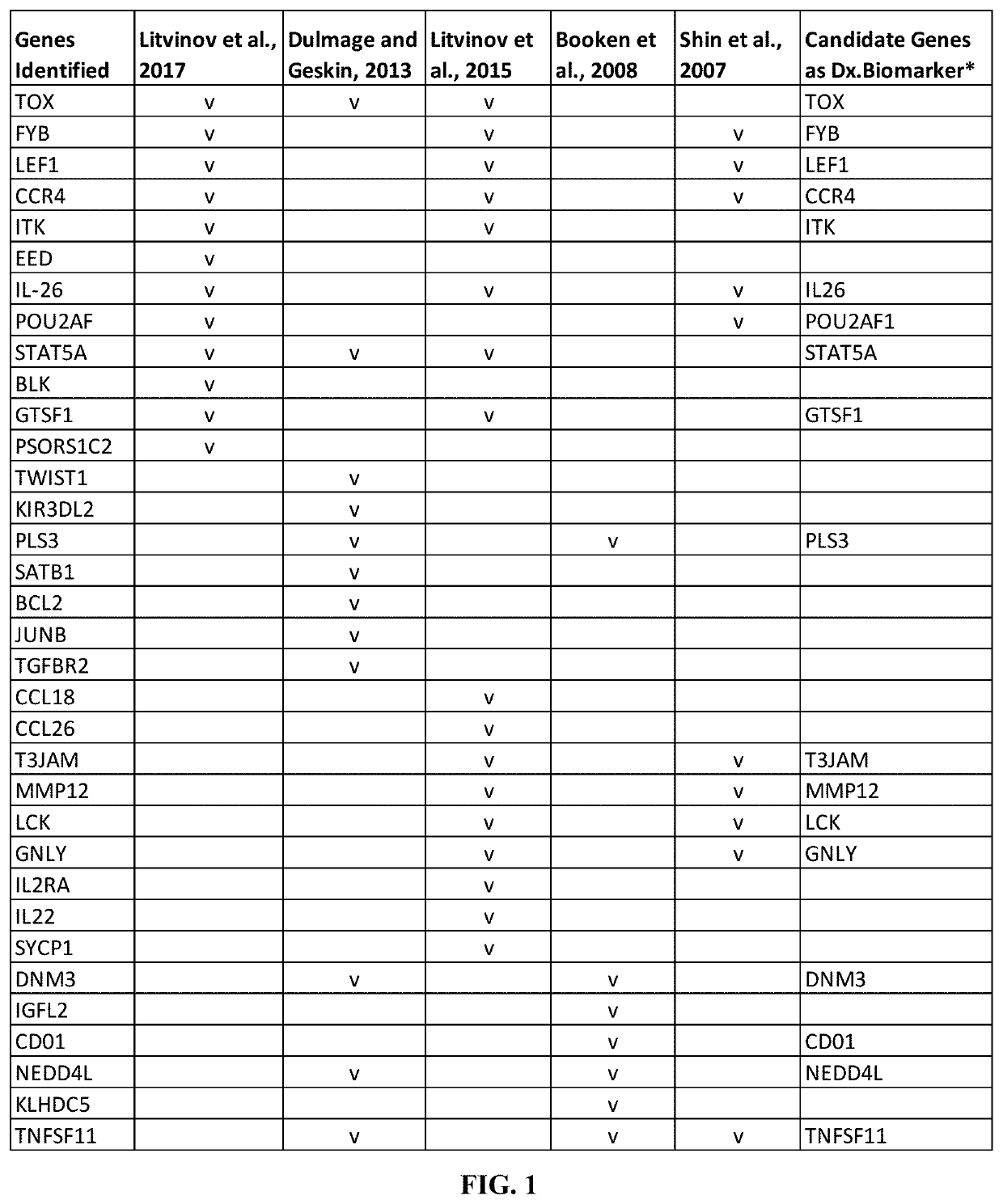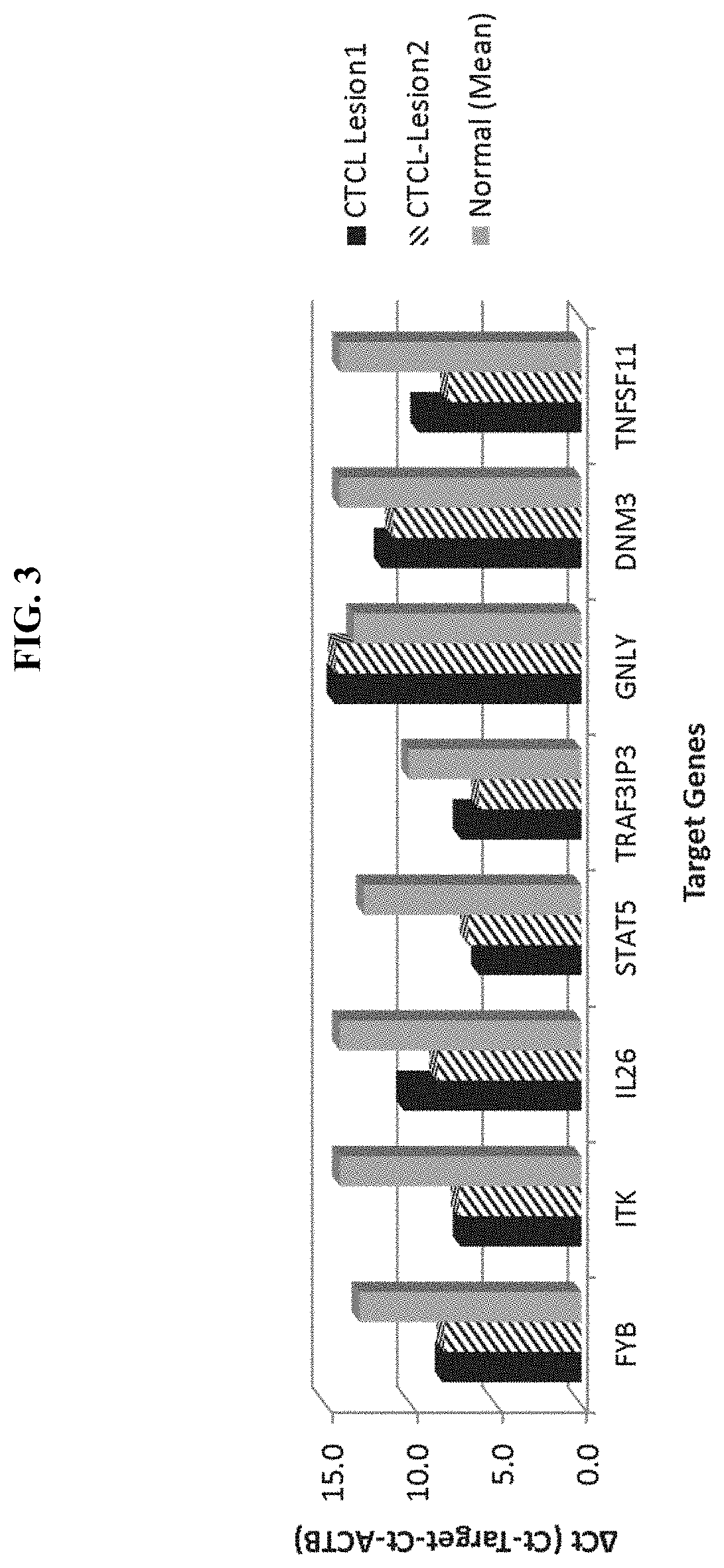Novel gene classifiers and uses thereof in skin cancers
a technology of gene classifiers and skin cancers, applied in biochemistry equipment and processes, peptide/protein ingredients, organic active ingredients, etc., can solve problems such as the burden on healthcare the world over
- Summary
- Abstract
- Description
- Claims
- Application Information
AI Technical Summary
Benefits of technology
Problems solved by technology
Method used
Image
Examples
example 1
[0343]Epidermal skin samples (lesional and non-lesional samples) were collected with non-invasive adhesive patches. Total RNA was extracted from the skin samples on adhesive patches with a silica-coated magnetic bead-based extraction method. qRT-PCR was utilized for measurement of gene expression of both target genes and a house keeping gene. Quantification of the target expression utilized a Ct measurement of both the target and housekeeping genes measured in parallel in the qRT-PCR, and changes of the target gene expression in test samples were presented as ΔCt, where ΔCt=Ct.target−Ct.housepeeking. A smaller ΔCt value indicates a stronger (or increased) gene expression in the test samples, and vice versa. Changes of the target gene expression in lesional samples compared to control samples (either non-lesional or normal skin samples) were calculated from the ΔCt values of both lesional and control samples, and presented as ΔΔCt, where ΔΔCt=ΔCt.lesion−ΔCt.control. A smaller ΔΔCt in...
example 2
[0350]Additional skin samples, all collected with adhesive patches, were analyzed for gene expression changes by RT-qPCR following the procedures in Example 1. A total of 23 samples were included in the analysis. The samples included 12 CTCL samples and 11 normal skin samples, among which 6 were paired lesional and normal skin samples (i.e. each pair of sample came from one test subject or patient) and the rest were unpaired samples (lesional and normal skin samples from different test subjects).
[0351]The gene expression analysis included Ct values of target and housekeeping gene (ACTB) in qPCR from each sample; ΔCt values (=Ct_target−Ct_ACTB), for normalized gene expression levels in each sample; ΔΔCt values (=ΔCt Lesion−ΔCt_NML), for changes in gene expression in lesional skins compared to normal skins in the paired samples (only the paired samples); P-values from statistical analysis of gene expression differences (based on ΔCt values) between the 2 groups of skin samples (lesion...
example 3
[0353]Skin samples will be collected with adhesive patches, and analyzed for changes in microRNA expression levels in CTCL lesion samples compared to paired normal skin samples. The expression levels of the following microRNAs will be analyzed to determine which are upregulated or downregulated compared to the control skin samples: miR-21, miR-27b, miR-29b, miR-30c, miR-34a, miR-93, miR-141 / 200c, miR-142, miR-146, miR-148a, miR-152, miR-155, miR-181a / b, miR-186, miR-203, miR-205, miR-214, miR-221, miR-326, miR-486, miR-663b, and miR-711. In some embodiments, the microRNA comprises miR-21, miR-29b, miR-155, miR-186, miR-214, and miR-221.
[0354]MicroRNA data will be grouped into with gene expression data from Example 2 to determine groupings of genes whose expression levels work exceptionally well for differentiating CTCL lesions from non-CTCL samples, compared to the individual gene expression levels.
PUM
| Property | Measurement | Unit |
|---|---|---|
| length | aaaaa | aaaaa |
| length | aaaaa | aaaaa |
| length | aaaaa | aaaaa |
Abstract
Description
Claims
Application Information
 Login to View More
Login to View More - R&D
- Intellectual Property
- Life Sciences
- Materials
- Tech Scout
- Unparalleled Data Quality
- Higher Quality Content
- 60% Fewer Hallucinations
Browse by: Latest US Patents, China's latest patents, Technical Efficacy Thesaurus, Application Domain, Technology Topic, Popular Technical Reports.
© 2025 PatSnap. All rights reserved.Legal|Privacy policy|Modern Slavery Act Transparency Statement|Sitemap|About US| Contact US: help@patsnap.com



